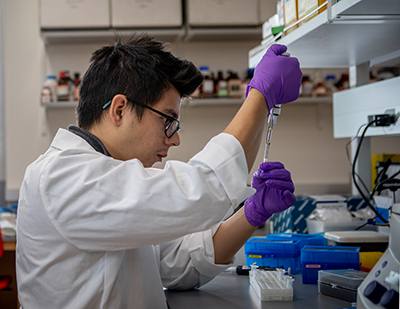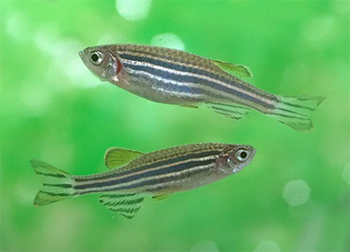COVID-19 Impacts WSU Student, Faculty Scientific Research
OGDEN, Utah – Weber State University science students and faculty have had to stay proactive, get inventive and adjust their research methods and communication as they continue to work during the outbreak of COVID-19.
 Weber State junior Xitlalli Villanueva, who is studying the effects of mining chemicals on brine shrimp in the Great Salt Lake and the food chain, was ready to begin her field research this summer, following two years’ preparation in the lab.
Weber State junior Xitlalli Villanueva, who is studying the effects of mining chemicals on brine shrimp in the Great Salt Lake and the food chain, was ready to begin her field research this summer, following two years’ preparation in the lab.
“I was doing research on the effect of methylmercury and mercury chloride on brine shrimp in the Great Salt Lake,” Villnueva said. “I was checking the toxicity levels of the brain and learning what the brain could withstand.”
Although brine shrimp are not directly related to humans, the effects these chemicals have could impact the entire food chain, Villanueva said. Most of the methylmercury and mercury chloride in the Great Salt Lake comes from neighboring mines. The effects of these chemicals on the shrimp have not been tested to date.
“It's important to be reminded that scientific research always goes back to the public and the everyday lives of people,” Villanueva said. “It's something that even though it's not impacting us directly, the methyl mercury, mercury chloride is going to eventually build up in our ecosystem and get back to us.”
Villanueva and fellow researchers set out to begin their field research to investigate the impact weeks before COVID-19 was declared a pandemic.
“There were a lot of things that we wanted to do,” she said. “My first two years of research were spent in the lab. This year, what I really wanted to do was focus more on being outdoors and studying brine shrimp from the environment. Because of COVID, it was a little hard to do that. I didn't have as much access to my professor, and all the lab equipment that I needed was on campus.”
In addition, Villanueva, who would have normally been living in the Ogden area in order to complete her research, stayed in Idaho with family. She commuted between Ogden and Idaho to work on her research over the summer. She returned full time to Ogden at the start of fall semester.
Villanueva also planned to attend the National Conference for Undergraduate Research at Montana State University in March and connect with other scientists studying methylmercury, but the conference was canceled. The research she hoped to have ready for publication within the next year will probably be delayed, but she plans to continue her work partly because the pandemic has underscored the need for quality research. She was disappointed that she did not have the opportunity to collaborate with other researchers at this conference. “You can't really share ideas how you would usually share them and you can't get others' voices in your research on how you could improve as you would in person.”
 As science students and faculty have adjusted to learning and teaching under the new constraints, some professors are concerned about the lack of personal interaction with online classes. Zoology professor Nicole Berthelemy often needs to demonstrate proper procedures for equipment and assist students who are learning new techniques such as measuring and transferring liquids through a pipette.
As science students and faculty have adjusted to learning and teaching under the new constraints, some professors are concerned about the lack of personal interaction with online classes. Zoology professor Nicole Berthelemy often needs to demonstrate proper procedures for equipment and assist students who are learning new techniques such as measuring and transferring liquids through a pipette.
“I had one student a while back who didn’t understand the dial measuring mechanism on a pipette,” Berthelemy said. “I tried a number of times to explain it to her, but she ended up breaking the instrument. I’m worried that will happen more often now that I can’t interact with the students in person.”
Fellow zoology professor Elizabeth Sandquist said COVID-19 has had a definite effect on the research community worldwide, but the level of impact has varied across the country.
“I interact with scientists from a variety of institutions on Twitter, and have found that undergraduate institutions have been particularly affected in comparison with research intensive universities,” Sandquist said. “Undergraduate researchers require more one-on-one supervision to perform research, while graduate students and postdoctoral fellows are able to work independently on campus if they maintain social distancing. In addition, the spread of the coronavirus varies geographically, and each research institution has its own requirements for social distancing. One university may have completely shut down research laboratories, while another may allow research at the scientists' discretion. Even within the same university, scientists report differences in activity from one lab to the next.”
In the spring, Sandquist began a collaboration with Jim Hutchins, WSU professor of health sciences, to study the impact of autism on synaptogenesis, the formation of synapses between neurons in the nervous system. According to Sandquist, they have still been able to research the topic and plan experiments with students through regular online meetings. Students have been able to access manuscripts related to this topic through WSU’s Stewart Library. They have been able to write and share summaries of their findings.
 Sandquist encourages the involvement of undergraduates in research. Students in her lab learn immunohistochemistry, in situ hybridization, fluorescent microscopy, CRISPR-mediated genome editing and zebrafish husbandry. “They also gain valuable skills in scientific literacy, experiment design and science communication.”
Sandquist encourages the involvement of undergraduates in research. Students in her lab learn immunohistochemistry, in situ hybridization, fluorescent microscopy, CRISPR-mediated genome editing and zebrafish husbandry. “They also gain valuable skills in scientific literacy, experiment design and science communication.”
Weber State science faculty have adapted through the aid of technology, finding innovative ways to creatively teach and engage virtually. As with his colleagues, earth and environmental science professor Dave Matty spent the summer prepping for a new style of teaching with a combination of video, zoom and online instruction.
“I guess the thing to remember about this entire situation is that we’re all going to have to adapt,” Matty said in a video explaining how the semester will work.
College of Science (COS) faculty also created engaging online activities both for university students and for the community.
"Weber State College of Science faculty have an ongoing commitment to high–impact, experiential teaching and learning, and much of this active teaching and learning occurs in lab and field settings,” says Andrea Easter-Pilcher, College of Science dean. “Though we may not be able to pursue the level of lab and field experiences and undergraduate research that we prefer due to COVID restrictions, I have watched in admiration as COS faculty and students have continued their research within COVID restriction guidelines. We will persevere through this, and our students will continue to benefit from the dedication, innovation and creativity of our faculty."
For more information about the College of Science, visit .weber.edu/cos.
For more news about Weber State University, visit weber.edu/wsutoday.
Melissa Smith, Office of Marketing & Communications
801-626-6348 • melissasmith9@weber.edu- Contact:
Alicia Miller, College of Science
801-626-6229 • amiller@weber.edu